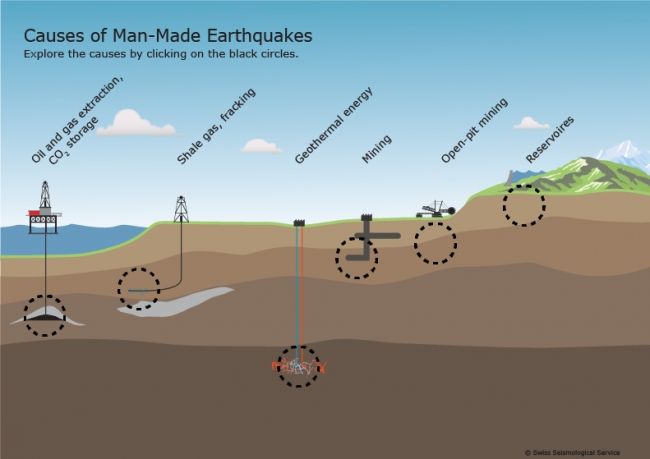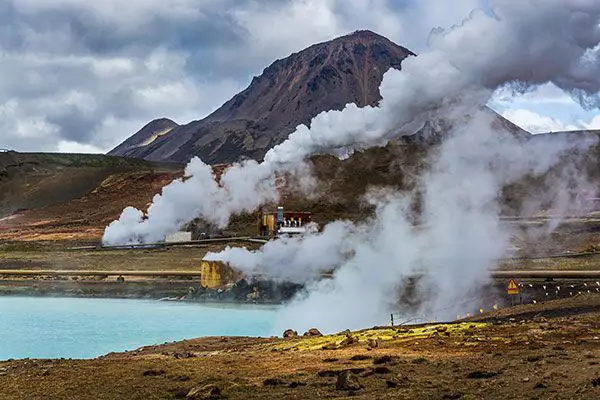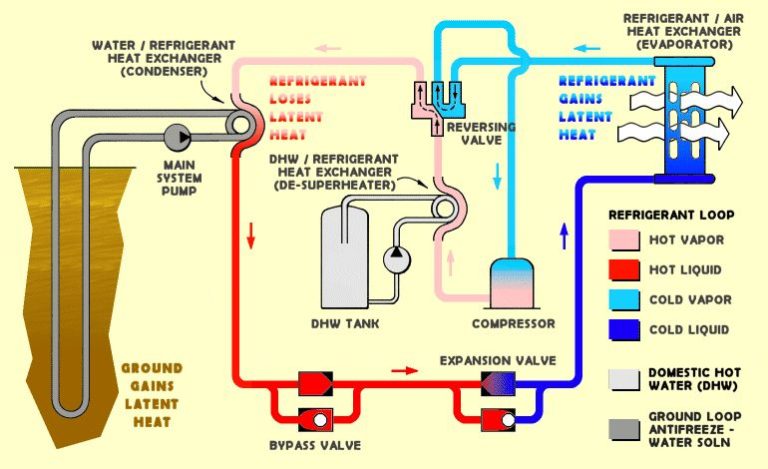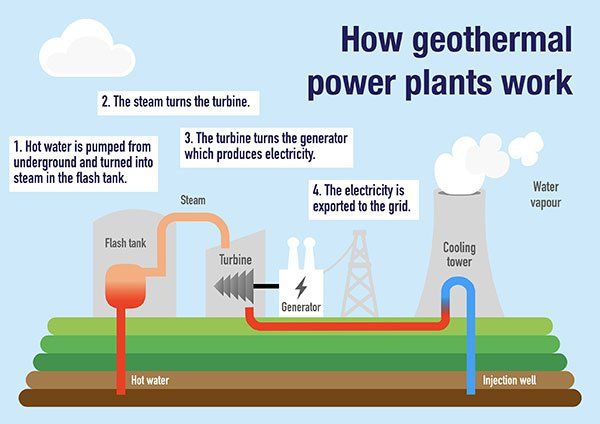Geothermal Energy’S Environmental Footprint: A Closer Look
Geothermal energy is a renewable source of energy that harnesses heat from within the earth. Geothermal power plants tap into reservoirs of hot water or steam deep below the earth’s surface to generate electricity. There are three main types of geothermal energy systems:
- Hydrothermal systems, which tap into naturally occurring reservoirs of steam or hot water
- Enhanced geothermal systems (EGS), which inject water into hot dry rocks to create geothermal reservoirs
- Direct use and district heating systems, which use hot water from reservoirs directly for heating purposes
Geothermal energy is considered a clean and sustainable energy source because it does not burn fossil fuels. However, geothermal power plants do have some environmental impacts that should be considered.
Geothermal’s Emissions
Geothermal energy has substantially lower lifecycle greenhouse gas emissions compared to conventional fossil fuel power plants. According to the U.S. Department of Energy, the lifecycle carbon dioxide emissions from a typical geothermal power plant are just 38 grams per kilowatt-hour of electricity generated. This is roughly 5% of the lifecycle emissions from a natural gas power plant and 1% of the emissions from a coal-fired power plant.
The low emissions for geothermal stem from the fact that the Earth’s heat is used as the energy source, rather than burning fossil fuels to generate electricity. The steam and heat used in geothermal plants is naturally occurring and does not require any combustion. While some indirect emissions are associated with the construction, drilling, and maintenance of geothermal plants, these emissions are minimal compared to those from exhaust stacks on fossil fuel power plants. Overall, geothermal can provide carbon-free, renewable baseload power at a very low emissions intensity compared to conventional generation technologies.
Water Usage
Geothermal power plants use water for cooling and steam generation. On average, geothermal plants use about 1,400 gallons of water per megawatt-hour of electricity produced. This is significantly lower than nuclear and coal plants, which can use over 20,000 gallons per megawatt-hour. However, geothermal still uses more water than natural gas, solar PV, and wind energy.
Water usage depends on the type of geothermal plant. Binary cycle plants, which utilize lower temperature reservoirs, use closed-loop systems and have minimal water loss through evaporation. Flash steam plants require water to condense the steam after passing through the turbine, resulting in greater water consumption through evaporation. Systems can be designed to limit water loss, but balancing efficiency and water use remains an engineering challenge.
Dry steam plants, which tap directly into underground steam, have essentially zero water loss. However, these sites are rare. Most geothermal reservoirs produce hot water, not steam, necessitating more complex power plant engineering.
Overall, geothermal power’s moderate water requirements can make it a good option in water-stressed regions compared to other technologies. But project siting must still consider available water resources and potential impacts on local supply. With prudent management, geothermal can provide reliable baseload power with less pressure on water than conventional alternatives.
Land Use
Geothermal power plants have a relatively small land footprint compared to other energy sources. A typical 50 MW geothermal power plant requires around 0.2-5 square miles of land. This is several times smaller than a comparable coal (4.4 square miles), natural gas (1.2 square miles), or nuclear plant (1.3 square miles).
Even large geothermal plants, generating several hundred megawatts, require a land area under 10 square miles. In contrast, utility-scale solar farms can sprawl across 10-60 square miles to generate similar capacity. Wind farms have a light footprint per turbine but spread turbines widely across large areas.
The reason geothermal plants have modest land needs is that the wells and power generating equipment are concentrated in a small area, with minimal auxiliary facilities required. After initial construction, the land can often be restored and available for other compatible uses such as grazing.
Additionally, geothermal reservoirs are not depleted over time like fossil fuel reservoirs. The geothermal resource can be sustained indefinitely with proper management of the reservoir. This avoids the need to continually expand extraction across new land areas.
Seismic Activity
One environmental concern related to geothermal energy is the potential to induce small earthquakes through water injection during geothermal reservoir development. The high-pressure injection of water into hot rock formations to create geothermal reservoirs has been known to cause microseismic events or small earthquakes, usually less than a 3.0 magnitude.

While most of these microseismic events cause little to no damage on the surface, larger triggered earthquakes have occurred in some instances. For example, water injection activities at the Basel geothermal project in Switzerland resulted in a 3.4 magnitude earthquake in 2006 that caused some structural damage to local buildings.
To mitigate seismic risks, geothermal operators closely monitor injection activities and geological conditions. Regulations generally require stopping injection if seismic activity exceeds certain thresholds. Overall, induced seismic activity remains a point of concern that is actively managed and monitored during geothermal reservoir creation and operation.
Wildlife Impacts
Geothermal facilities can impact local wildlife in a few key ways. Construction of power plants and associated infrastructure like roads and transmission lines can fragment habitat and disrupt wildlife. Wildlife may also be directly impacted by encounters with turbines, steam discharges, or vehicular traffic. Some specific wildlife concerns with geothermal development include:
– Habitat loss and fragmentation from clearing land for geothermal plants. This can reduce available habitat for sensitive species.
– Noise and lighting at facilities, which can disrupt normal behaviors of wildlife.
– Mortality risks such as turbine strikes for birds and bats.
– Displacement of wildlife from high quality habitat.
– Impacts to aquatic species from redirected water flows or discharges.
– Introduction of invasive species that can outcompete native species.
Proper siting, mitigation strategies, and habitat restoration efforts can help reduce the wildlife impacts of geothermal plants. Monitoring wildlife mortality and movement around facilities provides data to guide impact reduction efforts as well. Overall, geothermal’s wildlife impacts are modest compared to fossil fuels, but should still be evaluated and addressed.
Visual Impacts
Geothermal power plants have a significant visual impact on the landscapes where they are built. The plants feature large, tall cooling towers that emit large plumes of steam into the air. The towers and plumes can often be seen from many miles away. In addition, geothermal plants require networks of pipelines, pumps, drilling rigs, and other industrial equipment that are visually intrusive on the natural landscape.
While some geothermal plants are located in remote areas with low visibility, others are built near parks, forests, and scenic areas. The steam plumes in particular can detract from scenic vistas and dark night skies that natural landscapes are known for. There are growing concerns that the expanding footprint of geothermal plants is marring natural scenery that has important economic, recreational and spiritual value.
Compared to other renewable energy sources like solar and wind, geothermal often has a larger permanent visual footprint on the landscape. While some efforts have been made to mitigate visual impacts through plant design, steaming plumes and industrial equipment remain highly visible.
Waste Disposal
Geothermal power plants generate minimal amounts of waste compared to other energy sources. However, they do produce some byproducts that require proper handling and disposal. The primary waste products are:
Wastewater – Geothermal fluids brought to the surface contain contaminants like silica, salt, and sulfur compounds. These are removed before the water is reinjected into the reservoir. The extracted contaminants are disposed of according to environmental regulations.
Sludge – Sludge accumulates in the bottom of cooling towers and pipelines from particulate matter in geothermal fluids. This must be periodically removed and disposed of properly.
Scale Deposits – Scales from mineral precipitation can build up on equipment like heat exchangers. These need to be cleaned off and disposed of safely.
Spent Absorbents – Absorbent materials are used to clean up spills of geothermal fluids. Once used, these absorbents must be replaced and discarded appropriately.
Proper handling and disposal prevents geothermal waste products from contaminating soil or water resources. Facilities are required to have waste management plans to ensure minimal environmental impact.
Regulatory Oversight
Geothermal energy projects in the United States are subject to regulations at both the federal and state level. Key federal regulations include:
- The Geothermal Steam Act of 1970, which oversees leasing of federal lands for geothermal development.
- The National Environmental Policy Act, which requires environmental impact assessments for major federal actions like geothermal leasing.
- The Clean Air Act, which regulates geothermal plant emissions.
- The Clean Water Act, which regulates geothermal wastewater disposal.
- The Safe Drinking Water Act, which regulates reinjection of geothermal fluids.
At the state level, geothermal projects must obtain various permits and comply with state environmental regulations pertaining to air and water quality, land use, wildlife impacts, and more. States also oversee well drilling permits and regulate underground injection of geothermal wastewater. While regulations vary by state, most have guidelines in place to mitigate potential environmental impacts of geothermal development.
Conclusion
Studying the environmental footprint of geothermal energy has given us a window into the larger debate around renewable energy. On one hand, geothermal can provide carbon-free baseload power to aid the clean energy transition. On the other hand, projects must be properly sited, operated, and monitored to minimize impacts on water, land, seismicity, wildlife, and local communities. While no energy source is perfect, geothermal overall has a smaller footprint than fossil fuels. With thoughtful planning and regulatory oversight, geothermal can be an important part of building a sustainable energy future.




